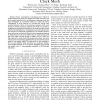Free Online Productivity Tools
i2Speak
i2Symbol
i2OCR
iTex2Img
iWeb2Print
iWeb2Shot
i2Type
iPdf2Split
iPdf2Merge
i2Bopomofo
i2Arabic
i2Style
i2Image
i2PDF
iLatex2Rtf
Sci2ools
ASPDAC
2015
ACM
2015
ACM
Modeling and optimization of low power resonant clock mesh
—Power consumption is becoming more critical in modern integrated circuit (IC) designs and clock network is one of the major contributors for on-chip power. Resonant clock has been investigated as a potential solution to reduce the power consumption in clock network by recycling the energy with on-chip inductors. Most of the previous resonant clock work focuses on H-tree structures, while in this work, we propose a modeling and optimization method for the mesh structure, which suffers from the high power consumption more seriously than the tree structure. Closed-form expressions for the transfer function, skew, and power are derived. Based on these expressions, impacts of design factors, such as the buffer size, LC tank location, grid size, wire width, and the sparsity of buffers and LC tanks, are fully explored to make trade-offs among power, skew, and area, which can be used as design guidelines for top level resonant clock mesh in early design stages. The exploration is also exten...
ASPDAC 2015 | Hardware |
| Added | 16 Apr 2016 |
| Updated | 16 Apr 2016 |
| Type | Journal |
| Year | 2015 |
| Where | ASPDAC |
| Authors | Wulong Liu, Guoqing Chen, Yu Wang, Huazhong Yang |
Comments (0)

